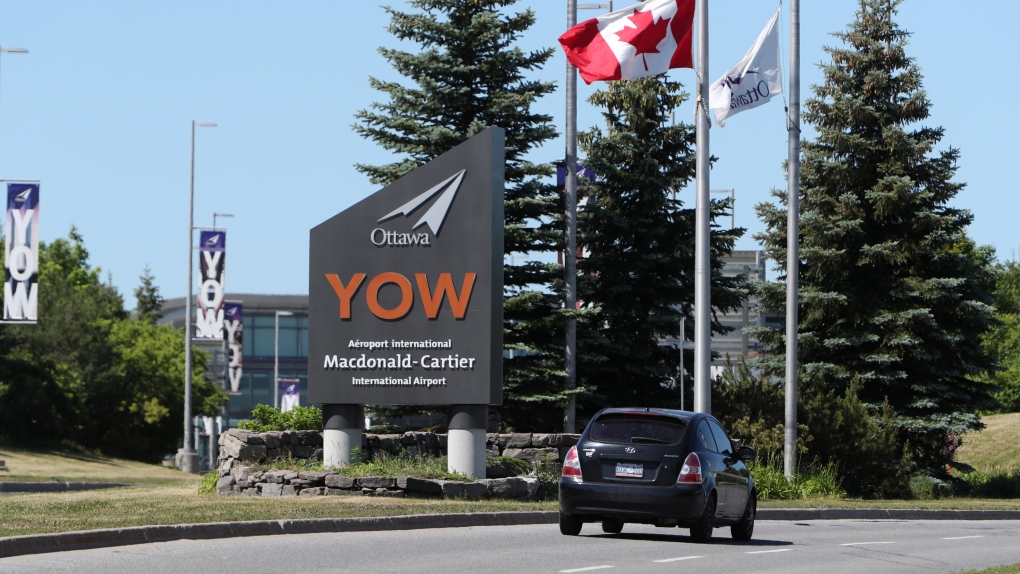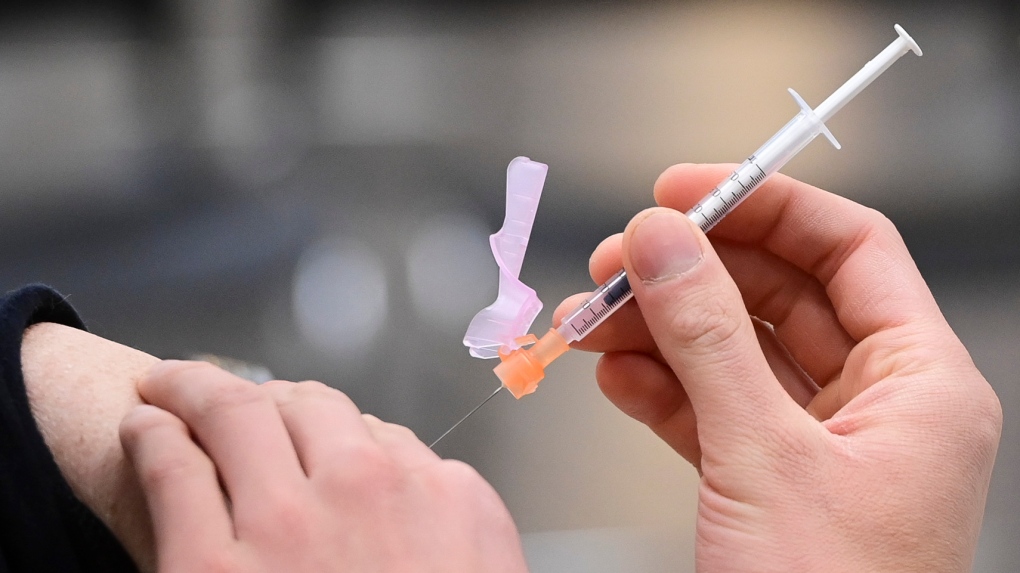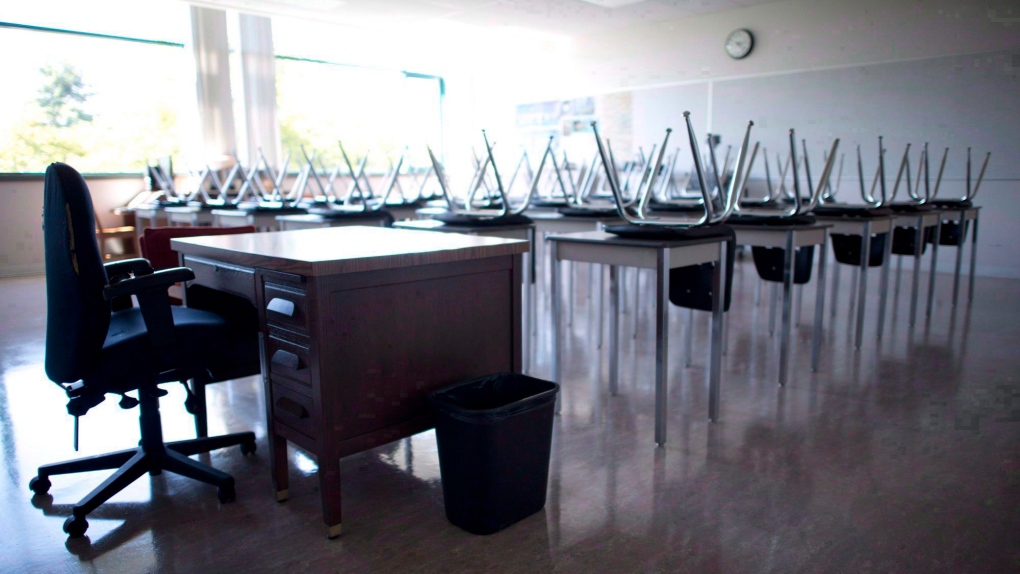COVID-19 in Ottawa: Fast Facts for Aug. 12, 2021
 The Ottawa MacDonald-Cartier International Airport on Wednesday, June 16, 2021. (David Kawai/THE CANADIAN PRESS)
The Ottawa MacDonald-Cartier International Airport on Wednesday, June 16, 2021. (David Kawai/THE CANADIAN PRESS)
Good morning. Here is the latest news on COVID-19 and its impact on Ottawa.
Fast Facts:
- The Federal Government says vaccine passports for foreign travel expected this fall
- The Ottawa neighbourhood of Ledbury – Heron Gate – Ridgemont has the lowest vaccination rate, with 46.4 per cent of residents 12 and older fully vaccinated
- Leeds, Grenville and Lanark counties continue to lead province in vaccination rates
- Active cases of COVID-19 in Ottawa continue to rise
- Ontario releases new school COVID-19 guidelines for self-isolation and outbreaks
COVID-19 by the numbers in Ottawa (Ottawa Public Health data):
- New COVID-19 cases: 10 new cases on Wednesday.
- Total COVID-19 cases: 27,903
- COVID-19 cases per 100,000 (previous seven days): 7.8
- Positivity rate in Ottawa: 0.8 per cent (seven day average)
- Reproduction Number: 1.20 (seven day average)
Testing:
Who should get a test?
Ottawa Public Health says you can get a COVID-19 test at an assessment centre, care clinic, or community testing site if any of the following apply to you:
- You are showing COVID-19 symptoms;
- You have been exposed to a confirmed case of the virus, as informed by Ottawa Public Health or exposure notification through the COVID Alert app;
- You are a resident or work in a setting that has a COVID-19 outbreak, as identified and informed by Ottawa Public Health;
- You are a resident, a worker or a visitor to long-term care, retirement homes, homeless shelters or other congregate settings (for example: group homes, community supported living, disability-specific communities or congregate settings, short-term rehab, hospices and other shelters);
- You are a person who identifies as First Nations, Inuit or Métis;
- You are a person travelling to work in a remote First Nations, Inuit or Métis community;
- You received a preliminary positive result through rapid testing;
- You are a patient and/or their 1 accompanying escort travelling out of country for medical treatment;
- You are a farm worker;
- You are an educator who cannot access pharmacy-testing; or
- You are in a targeted testing group as outlined in guidance from the Chief Medical Officer of Health.
- Long-term care staff, caregivers, volunteers and visitors who are fully immunized against COVID-19 are not required to present a negative COVID-19 test before entering or visiting a long-term care home.
Where to get tested for COVID-19 in Ottawa:
There are several sites for COVID-19 testing in Ottawa. To book an appointment, visit https://www.ottawapublichealth.ca/en/shared-content/assessment-centres.aspx
- The Brewer Ottawa Hospital/CHEO Assessment Centre: Open Monday to Friday 10 a.m. to 5:30 p.m. Saturday and Sunday 8:30 a.m. to 3:30 p.m.
- COVID-19 Drive-Thru Assessment Centre at 300 Coventry Road: Open seven days a week from 10 a.m. to 2 p.m.
- The Moodie Care and Testing Centre: Open Monday to Friday from 8 a.m. to 3:30 p.m.
- The Ray Friel Care and Testing Centre: Open Monday to Friday from 8 a.m. to 3 p.m.
- North Grenville COVID-19 Assessment Centre (Kemptville) – 15 Campus Drive: Open Monday to Friday 9 a.m. to 5 p.m. Sunday from 9 a.m. to 1 p.m.
- Centretown Community Health Centre: Open Monday, Tuesday, Wednesday, Friday from 9 a.m. to 4 p.m.
- Sandy Hill Community Health Centre: Open Monday to Friday from 9 a.m. to 3 pm.
- Somerset West Community Health Centre: Open from 9 a.m. to 4 p.m. Monday to Wednesday, 1 p.m. to 4 p.m. Thursday and 9 a.m. to 2:30 p.m. on Friday
COVID-19 screening tool:
The COVID-19 screening tool for summer camp children and staff. All campers and staff must complete the COVID-19 School and Childcare screening tool daily.
Symptoms:
Classic Symptoms: fever, new or worsening cough, shortness of breath
Other symptoms: sore throat, difficulty swallowing, new loss of taste or smell, nausea, vomiting, diarrhea, abdominal pain, pneumonia, new or unexplained runny nose or nasal congestion
Less common symptoms: unexplained fatigue, muscle aches, headache, delirium, chills, red/inflamed eyes, croup
Vaccine passports for foreign travel expected this fall
The federal government says vaccine passports for foreign travel will be ready this fall.
Immigration Minister Marco Mendicino says the government document will certify your COVID-19 vaccine history for the purpose of international travel.
Mendicino says it will include data on the type of vaccines received, the dates and the location they were given.
"I want to take a moment to thank all Canadians who've rolled up their sleeves over these past months," he said. "As more and more are getting vaccinated they are planning for life in a post-vaccinated world, including the safe return to travel."
The document will not be intended to use domestically.
 The Ottawa MacDonald-Cartier International Airport on Wednesday, June 16, 2021. (David Kawai/THE CANADIAN PRESS)
The Ottawa MacDonald-Cartier International Airport on Wednesday, June 16, 2021. (David Kawai/THE CANADIAN PRESS)
These Ottawa neighbourhoods have the highest and lowest COVID-19 vaccination rates
Ottawa Public Health is setting up new Neighbourhood Vaccine Hubs to address systemic barriers that may be preventing access to COVID-19 vaccines for residents in some areas of the city.
A new report concludes that “vaccination coverage is generally lower in neighbourhoods with less socioeconomic advantage than in neighbourhoods with higher socioeconomic advantage."
New data shows the neighbourhood of Ledbury – Heron Gate – Ridgemont has the lowest vaccination rate in Ottawa, with 46.4 per cent of residents 12 and older fully vaccinated. The neighbourhood of Hawthrone Meadows-Sheffield Glen has the second-lowest vaccination coverage in Ottawa, with 50.2 per cent of residents 12 and older fully vaccinated with two doses.
The neighbourhoods with the highest vaccine coverage are Vars, Hunt Club South Industrial and Cumberland, all with over 90 per cent first dose coverage and 80 per cent of adults 12 and older fully vaccinated.
 Health-care worker Thi Nguyen administers Pfizer-BioNtech COVID-19 vaccine to a patient at a COVID-19 clinic in Ottawa on Tuesday, March 30, 2021. (Sean Kilpatrick/THE CANADIAN PRESS)
Health-care worker Thi Nguyen administers Pfizer-BioNtech COVID-19 vaccine to a patient at a COVID-19 clinic in Ottawa on Tuesday, March 30, 2021. (Sean Kilpatrick/THE CANADIAN PRESS)
Leeds, Grenville and Lanark Counties continue to lead province in vaccination rates
The Leeds, Grenville and Lanark District Health Unit is leading Ontario in COVID-19 vaccination coverage.
As of Aug. 7, 89.3 per cent of people 12 and older have had their first shot, with 79.7 per cent fully vaccinated.
"It's been an entire community response. That's the best way I can sum it up," said Dr. Paula Stewart, chief medical officer of health for the Leeds, Grenville and Lanark (LGL) District Health Unit.
"There's a commitment among our population to be vaccinated because they understand how important it is for them as individuals, their family members and others," Dr. Stewart said.
Active COVID-19 cases in Ottawa rise Wednesday; 10 new cases, 0 deaths
Ottawa Public Health reported 10 new cases of COVID-19 in Ottawa on Wednesday, and no new deaths linked to the virus.
The number of known active cases of COVID-19 is now above 70.
Since the first case of COVID-19 in Ottawa in March 2020, there have been 27,903 laboratory-confirmed cases of COVID-19 in Ottawa, including 593 deaths.
Ontario releases new school COVID-19 guidelines on self-isolation, outbreaks and cohort dismissals
The Ontario government's new guidelines for COVID-19 in school outlines different isolation rules for vaccinated students and staff.
The "COVID-19 Guidance School Case, Contact and Outbreak Management" document states that individuals who are fully vaccinated and asymptomatic are not required to isolate after a high-risk exposure to the virus.
Household members who live with a student that has been exposed to the virus do not need to self-isolate if they are fully vaccinated.
Those who are not fully immunized and were exposed to COVID-19 as a high-risk contact must isolate for 10 days. The guidelines indicate testing is recommended on day seven of their isolation period and the isolation should begin on the last day of the known exposure.
 FILE - AN empty teacher's desk is pictured at the front of a empty classroom at Mcgee Secondary school in Vancouver on Sept. 5, 2014. (Jonathan Hayward/The Canadian Press)
FILE - AN empty teacher's desk is pictured at the front of a empty classroom at Mcgee Secondary school in Vancouver on Sept. 5, 2014. (Jonathan Hayward/The Canadian Press)
CTVNews.ca Top Stories

Federal government to further limit number of international students
The federal government will be further limiting the number of international students permitted to enter Canada next year. It's the government's latest immigration-related measure to address Canadians' ongoing housing and affordability concerns.
Search for suspect in Kentucky highway shooting ends with discovery of body believed to be his
Authorities say they believe the body of a man suspected of shooting and wounding five people on a Kentucky interstate highway has been found.
Here's why you should get all your vaccines as soon as possible
With all these shots, some Canadians may have questions about the benefit of each vaccine, whether they should get every shot and how often to get them, and if it's safe to get them all at once or if they should space them out.
Bloc MPs will vote confidence in Liberal government next week: Blanchet
The Conservatives' first shot at toppling the Liberal government is likely doomed to fail, after Bloc Quebecois Leader Yves-François Blanchet told reporters his MPs will vote confidence in the government.
'I'm here for the Porsche': Video shows brazen car theft in Mississauga
Video of a brazen daylight auto theft which shows a suspect running over a victim in a stolen luxury SUV has been released by police west of Toronto.
Exploding electronic devices kill 20, wound 450 in second day of explosions in Lebanon
Lebanon's health ministry said Wednesday that at least 20 people were killed and 450 others wounded by exploding electronic devices in multiple regions of the country. The explosions came a day after an apparent Israeli attack targeting pagers used by Hezbollah killed at least 12 and wounded nearly 3,000.
'It starts off innocent': Manitoba man loses $185,000 to crypto-romance scam
A Manitoba man is warning others after he fell victim to an elaborate online scam over the summer.
Teen faces new charge in Sask. high school arson attack
A 14-year-old student who allegedly set her classmate on fire is facing a new charge.
Quebec woman charged with first-degree murder in death of five-year-old boy
A 29-year-old Quebec woman is facing a first-degree murder charge in the death of a five-year-old boy southwest of Montreal.


































